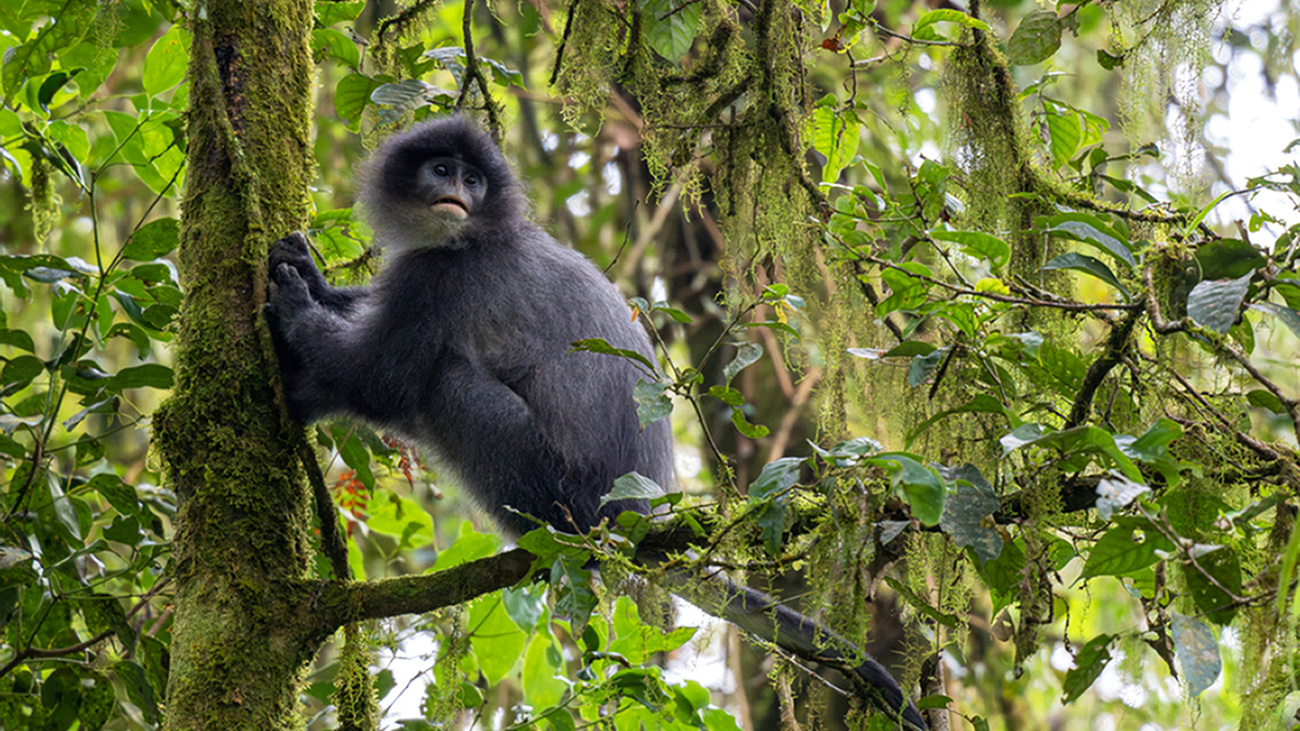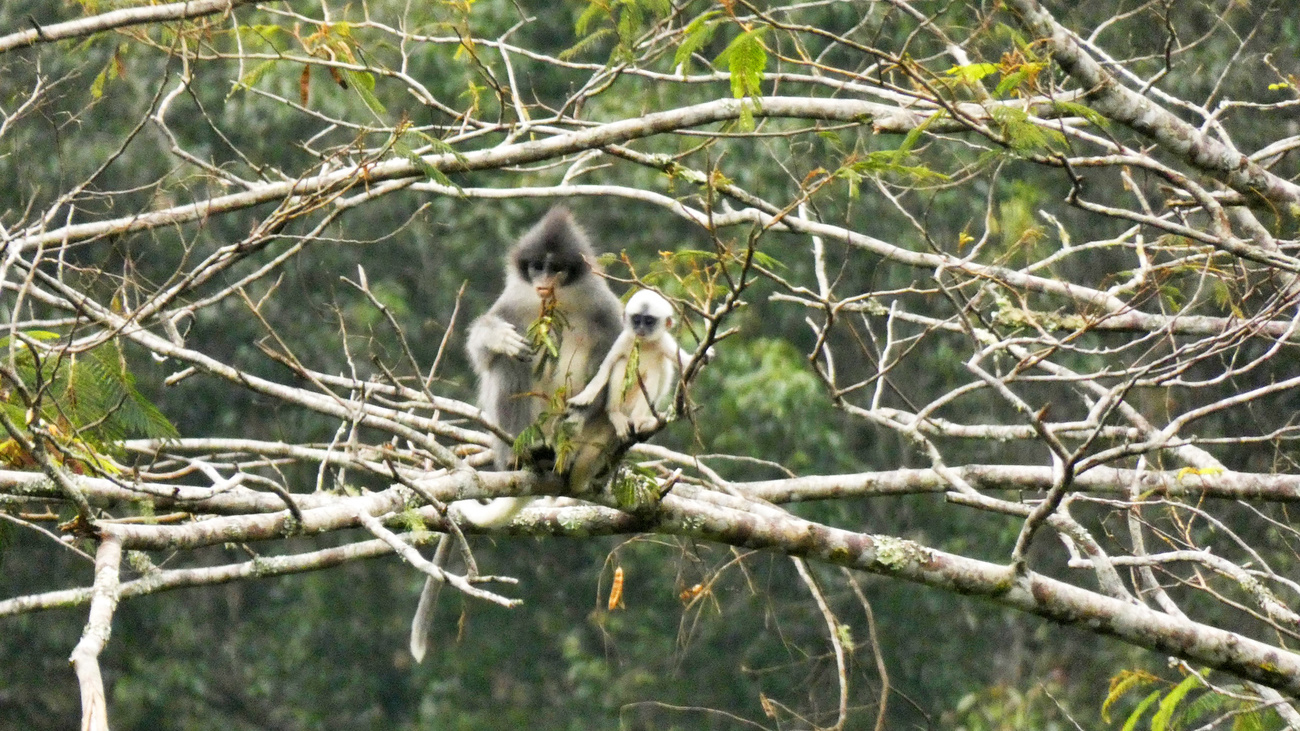Javan leaf monkeys
What is a Javan leaf monkey?
The Javan leaf monkey, also known as the grizzled leaf monkey, the Javan grizzled langur, or the Javan surili, is a species of monkey found only on the island of Java, Indonesia. They’re called ‘grizzled’ because of their long, wild fur that’s generally dark and speckled with lighter shades. They have light brown eyes set against a dark, hairless face and a mane of fuzzy hair that almost completely hides their ears. The color of their coat ranges from black to grey or whitish, with bright white fur across their chest and inner limbs, including their tails. They stand about one meter tall and have long, thin limbs.
Javan leaf monkeys live in family groups in which they form monandrous relationships. This means females choose a single male to mate with, while males mate with multiple females at a time. This style of relationship differs from polygamy because females eventually switch partners as well, usually because they decide to move to a new location or family group. When females give birth, the troop engages in ‘allomothering’, which means all females take turns looking after the infant. The lifespan of the Javan leaf monkey is unknown, but they reach sexual maturity at four to five years of age.
The life of Javan leaf monkeys involves a lot of resting and a lot of leaf-eating. Studies into the activities of Javan leaf monkeys in Gede Pangrango National Park showed that they spend 51% of their time resting, 23% foraging and eating food, 21% traveling, and 5% engaging in social or other activities.
Javan leaf monkeys play an important role in keeping the rainforest healthy thanks to their diet. As they eat large quantities of leaves and fruits and spend a lot of time roaming around different areas of the forest, they spread seeds through their feces, promoting plant growth. Their eating habits also result in the continuous pruning of trees and shrubs, which makes way for sunlight to reach the forest floor and help new plants grow.
What is a Javan leaf monkey’s scientific name?
The Javan leaf monkey’s scientific name is Presbytis comata, and they are part of the Colobinae family. The species has two close relatives that are likely the product of interbreeding called Presbytis comata comata and Presbytis comata fredericae. Scientists are currently investigating whether these variants are distinct species or subspecies of the Javan leaf monkey.
Are Javan leaf monkeys endangered?
The Javan leaf monkey was most recently assessed by the IUCN in March 2022 and is listed as vulnerable. However, the IUCN notes that the species is on the threshold between vulnerable and endangered and might be reassessed as endangered in the near future. The species needs to be continually observed to measure population decline and better estimate the number of mature individuals. Currently, the estimated population is between 2,300 and 5,500 mature individuals.
The main threats to Javan leaf monkeys are habitat destruction, hunting, and illegal trade.
Where do Javan leaf monkeys live?
Javan leaf monkeys are endemic to the volcanic island of Java. Java is also home to the rarest species of rhino, the Javan rhino, and many other unique animals. Indonesia is known as one of the world’s largest biodiversity hotspots.
These monkeys are primarily found in western Java, extending eastward into parts of central Java. Historically, Javan grizzled leaf monkeys were found all over the island, from sea-level areas to mountain areas as high as 2,500 meters. Currently, they are restricted mostly to fragments of mountainous habitats, congregating around Mount Sawal, Mount Dieng, Mount Lawu, and Mount Slamet. These are areas with high levels of rainfall, with Mount Slamet reaching as much as 671 centimeters (264 inches) of rainfall.
They like to live in tall forests in the middle and upper layers of the canopy, where they are safe from predators and can live off various species of leaves. Studies have found that populations that live at altitudes lower than 1,400 meters eat more fruits and seeds than those living higher up.
Threats
Habitat destruction, hunting, and illegal trade are all urgent issues that are threatening the Javan leaf monkey.

Habitat destruction
The rainforest habitats of Javan leaf monkeys have been slowly converted into farmland, settlements, and plantations over the past couple of centuries. Even with modern legislation in place, the forests continue to be illegally logged and felled to create things like wild orchids and pitcher plants. It’s estimated that as little as 4% of the Javan leaf monkey’s original habitat still exists today—and most of it is highly fragmented. Surviving populations exist in isolated pockets of land—unable to travel to new places, extend their territories, or join new troops from different areas. Roads, settlements, plantations, and other deforested land through which the monkeys can’t safely travel prevent them from roaming freely.
Hunting
When Javan leaf monkeys venture into human-settled areas, they’re often hunted for food or killed to protect crops. With the habitat so fragmented and the human settlements so small and isolated, it’s very difficult to enforce legislation that would protect the monkeys from this kind of persecution.
Illegal trade
Illegal trade is another threat faced by Javan leaf monkeys, particularly those in central Java. They can be sold live as pets or for eventual consumption as bushmeat, at prices ranging from 500,000 to one million Indonesian Rupiah—just $32.18 USD to $64.36 USD. Primates like Javan leaf monkeys are usually taken from the wild as babies, which often means their mothers are killed in the process.
FAQs
What do Javan leaf monkeys look like?
Javan leaf monkeys have dark skin which can be seen on their hairless faces. They have a mane of fuzzy fur surrounding their faces that ranges from black to dark grey to whitish, depending on the population. You can just about see their small ears popping out from under the fur, in about the same place as a human’s would be. While the main color of their fur varies, they always have white fur on their chests, bellies, and the underside of their limbs, providing a striking contrast for those with darker fur.
They have long torsos, thin arms and legs, and a protruding belly. Primed for climbing trees and carefully picking out leaves to eat, their hands have long, nimble fingers—along with the all-important thumb. Unlike humans, their toes are also long and their feet have their own thumb-like appendage to keep them safe and stable in the treetops. They also have long, thin tails that help them balance, though as nonprehensile tails, they can’t grasp objects.
How big are Javan leaf monkeys?
Both male and female Javan leaf monkeys are around the same size, weighing six to eight kilograms (13 to 18 pounds) and reaching heights of 108 centimeters (3.5 feet). Their tail length ranges from 50 to 85 centimeters (20 to 33 inches).

What do Javan leaf monkeys eat?
True to its name, the Javan leaf monkey lives on a diet mostly made up of leaves. They prefer young leaves over mature leaves, which are thought to be higher in protein and lower in toxins—though studies on this subject are sparse. In their natural forest habitats, Javan leaf monkeys are surrounded by hundreds of tree species, but they have specific preferences when it comes to food. Their favourite leaves come from ficus plants, grenadia, millaa millaa vines, and ki puyu shrubs.
Similar to other leaf-eaters, such as sloths, Javan leaf monkeys have multi-chambered stomachs that work to break down the stubborn cellulose fibers found in leaves. Without this adaptation, it’s very difficult to digest cellulose and gain nutrients from it—though this doesn’t stop some animals, like pandas and red pandas, from trying.
Alongside leaves, Javan leaf monkeys can also be found eating fruits, flowers, seeds, and even tree snails. Their favorite fruits are from the Lamiaceae and Actinidiacae families, and they avoid sweet and succulent fruits because the acidity can affect their natural pH level and cause digestive problems.
Are Javan leaf monkeys mammals?
As primates, Javan langur monkeys are indeed mammals. They can reproduce at any time of year, and after a gestation period of five to six months, the infant is born and fed on the mother’s milk for about a year.
What sounds do Javan leaf monkeys make?
Adult males use loud, long-distance calls for a variety of purposes, including defending food, attracting a mate, marking or defending territories, and locating troop members. These calls increase in volume as they continue, and studies have been performed to analyze them against the calls of other species.
Not a lot of research has been done into the vocalizations of other troop members, however. According to current observations, females and younger males are fairly quiet, but there may be other types of calls we haven’t seen yet. Though not sound, grooming is also thought to be a type of bonding and communication between monkeys, and this behavior has been spotted in female Javan leaf monkeys.
Do Javan leaf monkeys live in groups?
Yes, the Javan grizzled leaf monkey lives in small family groups with as many as 14 members. Troops most often include one adult male, several females, and their young. It’s not unheard of for a second adult male to join a group, but only one can be the leader. Some populations will even live in groups with another species of monkey, the spangled ebony langur. Javan leaf monkeys are territorial, and when neighboring groups meet each other, things can get hostile. Because their habitat is so fragmented, the size of a group’s home range greatly depends on where they are on the island and how much space is available.
Why are Javan leaf monkeys important?
Like many herbivores, Javan leaf monkeys play an important role in pruning the vegetation around them. By eating leaves, fruits, seeds, and shrubs, they constantly make room for new plants to grow and clear a path for sunlight to reach the forest floor. Through eating and excreting fruits and seeds, they also promote plant growth and fertilize the soil.
Our work
IFAW is dedicated to preventing the illegal trade of Javan leaf monkeys as pets. Together with Jakarta Animal Aid Network (JAAN) and the Wildlife Trust of India (WTI), we work to monitor social media and other communication channels that are used by illegal wildlife traders. By watching and collating information, we were most recently able to provide JAAN with enough actionable information for them to conduct an undercover investigation into the illegal sale of pangolins and orangutans in Indonesia.
After successfully meeting with the broker and confirming the live animals in their possession, a special police unit conducted a raid, and JAAN was able to rescue a baby orangutan, a Javan slow loris, a baby Javan gibbon, a pregnant Sunda pangolin, two Sunda leopard cats, and a Javan leaf monkey. From there, the animals will be treated and tested to determine their birth origins so we can find the best sanctuaries and carers for their unique needs. Our aim is always to safely return them to the wild.

How can you help?
Investigative work into the illegal wildlife trade requires around-the-clock monitoring of social and communication channels. Once these animals are rescued, they often require extensive care for their physical and psychological needs.